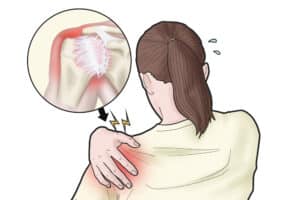Soft Tissue Injury Healing
What is Soft Tissue?
Soft tissues are any of a variety of tissues that support, connect, or surround other structures in the human body, and that are not rigid like bone. There are many types of soft tissues, such as fat, muscle, fibrous tissue (tendons, ligaments, fascia), synovial tissue (found at joints and other structures), blood vessels, lymph vessels, and peripheral nerves (nerves outside of the brain and spinal cord).
What is a Soft Tissue Injury?
A soft tissue injury is the damage that can occur at a localized area of soft tissue as the result of some sort of physical trauma or repetitive abuse. Soft tissue injuries can be classified into two categories:
- Acute
- Occur when there is a sudden, abnormal stress placed on the tissues, such as a physical blow or a rapid movement that the body is unprepared for. Some examples of acute soft tissues injuries include muscle or tendon strains, contusions, and ligament sprains.
- Overuse
- Occur over an extended period of repetitive stress that is placed on the tissues, such as overtraining or monotonous hobbies and/or jobs. Some examples of overuse soft tissue injuries include tendonitis and bursitis.
There are countless scenarios in which an individual might receive a soft tissue injury. Perhaps you ‘rolled’ your foot while hiking or stepping off a curb, which resulted in the spraining of a ligament in your ankle (an acute soft tissue injury). Or, maybe you have been going for a long run every morning on hard, flat pavement for the past several weeks. However, if you have poor footwear, or you simply don’t give your body enough time to recover, eventually you may find yourself suffering from medial tibial stress syndrome (‘shin splints’), patellofemoral pain syndrome (‘runner’s knee’), or Achilles tendinitis. All three of these are examples of overuse soft tissue injuries.
Nova Active Rehab specializes in recovery from injuries sustained in car accidents – acute soft tissue injuries (which often become chronic if not dealt with). This will be the focus for the remainder of this post.
The Stages of Healing of a Soft Tissue Injury
Once a soft tissue injury has occurred, the body will respond by initiating the healing process. There are three stages (or phases) of healing, which occur in the following order:
- Inflammatory stage
- Repair (proliferation) stage
- Remodeling (maturation) stage

The Inflammatory Stage
In the first stage of healing, the inflammatory stage, the body is responding rapidly to the onset of a soft tissue injury. Typical signs of inflammation include warmth, redness, pain and swelling, the latter two of which will serve to limit the function of the damaged tissues. This limitation is a protective mechanism, as it will help reduce the chance of further injury to the site.
Your body will also release a number of chemicals during this phase, which will cause a cascade of events that lead into the next stage of healing – the repair stage. The inflammatory stage is brief, lasting up to about five days. This phase of healing ends with the clotting of blood vessels, the mechanical protection against the entry of foreign bodies (if our internal system was exposed to the external environment, such as with a cut or scrape; scab formation), and the subsiding of the inflammatory response.
Following a car accident, here are some suggestions for recovery during this stage:
- Visit your family doctor as soon as possible (or the hospital if your injuries are severe enough)
- Focus on letting your body rest and heal (avoid any intense physical activity or movements that result in pain)
- If cleared by a physician, undergo some gentle, pain-free range of motion activities
- If cleared by a physician, utilize PRICE (protection, rest, ice, compression, elevation) to the injured site
The Repair Stage
The purpose of the repair stage of healing is to remove the dead tissue and debris from the site of the injury, and to replace it with new tissue. However, when the new tissue is formed, the structure of it is much less organized. This is largely because the new fibres are being deposited in random directions (as opposed to being neatly lined up, as in healthy tissue), resulting in a less functional tissue. This is referred to as scar tissue.
This phase begins shortly after the initial injury and can last several weeks (or longer) depending on the extent of the injury and the response from the individual’s body. As the inflammatory phase ends and the new tissues begins to form, there should be a gradual increase in function (strength, mobility, etc.). However, as mentioned prior, this scar tissue is still not as functional as the healthy tissue that existed prior to the injury, and so you should not expect to regain all your strength and mobility during this phase of healing.
Following a car accident, here are some suggestions for recovery during this stage:
- If cleared by a physician, undergo some passive and active range of motion activities that are within a reasonable pain tolerance (to avoid joint contractures, scar adhesions, and other issues that can limit your recovery)
- Consider seeking out some or all of the following professionals at this point: physiotherapists, chiropractors, massage therapists, occupational therapists
- Eventually this could be advanced into some progressive resisted exercises, as well as neuromuscular and proprioception retraining
The Remodeling Stage
The final stage of the healing process, the remodeling stage, begins once there is a sufficient amount of scar tissue in place. The purpose of this phase is to remodel the scar tissue over time into a more healthy, functional tissue. In order to ensure this occurs properly, the individual will have to introduce appropriate stimuli for the injured soft tissue, including a variety of movements or exercises that are gradually progressed in intensity.
From the onset of the remodeling stage at about a few weeks post-injury, this stage should last anywhere between about one to eighteen months. This is a massive range of time, which again will depend on a number of factors, such as the extent of the injury, the intervention of any professionals working with the individual, and the motivation and body responses of the individual during this phase. The goal at the end of this phase, and thus the end of the healing process, is to once again have a healthy, functional soft tissue at the site of the once-injured soft tissue. However, if the remodeling stage is not concluded successfully, then the individual may be bothered by pain, reduced mobility, and an overall limitation in function in the tissue long after the healing process has concluded.
Following a car accident, here are some suggestions for recovery during this stage:
- If cleared by a physician, begin a progressive return to all pre-injury activities by gradually restoring normal mobility, strength, conditioning, and proprioception through active rehabilitation
- This can be done with assistance by the previously mentioned professionals (physiotherapists, massage therapists, etc.) as well as kinesiologists, who are specialized in creating a structured, progressive, active rehabilitation program
References
Soft Tissues – http://www.cancer.ca/en/cancer-information/cancer-type/soft-tissue-sarcoma/soft-tissue-sarcoma/the-soft-tissues-of-the-body/?region=on
Soft Tissue Injury and Healing Stages – https://www.doctorsconvey.com/physical-therapy/soft-tissue-injury-healing-stages
Functional Assessment of the Spine and Extremities (FASE) Manual (2009 Edition)







